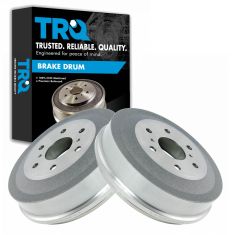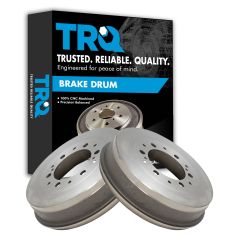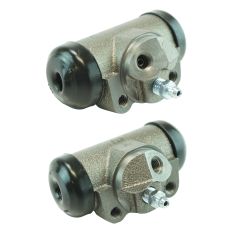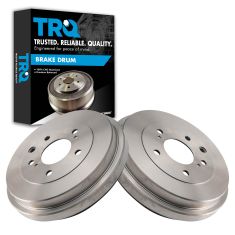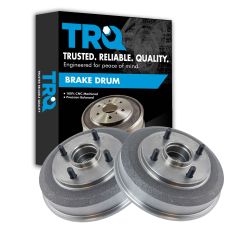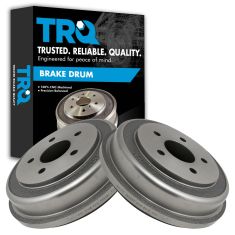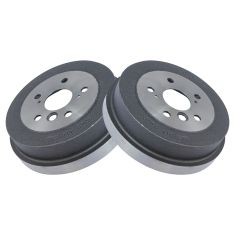Brake Drums
-
-
- Air Deflectors & Valance Panels
- Battery Trays & Related
- Body Panels
- Bumpers & Related - Front & Rear
- Convertible Tops, Soft Tops, & Parts
- Decal & Stripe Kits
- Emblems & Nameplates
- Engine Compartment Trim
- Frame Parts & Bushings
- Fuel Door Parts
- Fuel Tank Filler Neck
- Grille
- Header Panel
- Hood & Hatch Lift Supports
- Hood Latch & Catch Brackets
- Hood Release Cable
- Jack Pads
- Radiator Supports
- Rust Repair Panels
- Splash Shields & Fender Liners
- Tailgate Cables
- Tailgate Hinges & Related
- Weatherstripping
-
- Car Covers
- Exterior Lighting
- Exterior Parts & Accessories
- Exterior Safety & Security
- Exterior Storage
- Fender Flares
- License Plate Brackets & Frames
- Mud Flaps & Splash Guards
- Nerf Bars, Side Steps, Running Boards
- Radio Antenna
- Rain Deflectors
- Roll Bars, Light Bars, & Related
- Roof Rack
- Skid Plates
- Spare Tire Carriers & Related
- Spare Tire Covers
- Tire Care
- Tonneau Covers
- Tow Hooks & D-Shackles
- Towing Accessories
- Trailer Hitch & Components
-
- Accelerator Pedal Pad
- Auto Carpet
- Brake Pedal Pad
- Clutch Pedal Pad
- Console Parts
- Dash Pad Cover
- Dash Vents
- Floor Mats & Liners
- Horns & Horn Parts
- Interior Parts & Accessories
- Mirror - Interior Rear View
- Seat Cover and Sets
- Seat Heater Kits
- Seat Parts and Accessories
- Sun Visors & Related
- Trunk & Cargo Parts
-
- Accelerator Pedals & Sensors
- Alarms, Control Modules, & Remote Start
- Cruise Control Switch & Lever
- Electrical Parts
- Hazard Switch
- Ignition Key Lock Cylinder
- Ignition Switch
- Keyless Entry Remote & Related
- Neutral Safety Switch
- Parking Assist Cameras & Monitors
- Power Mirror Switch
- Power Seat Switches
- Power Window Switch
- Radio, Navigation, Entertainment
- Reverse Light Switch
- Trunk Release & Lock Solenoids
- Turn Signal Switches and Levers
- Windshield Wiper Switch
-
- Idler Arm
- Pitman Arm
- Power Steering Hoses
- Power Steering Oil Cooler
- Power Steering Pressure Sensor
- Power Steering Pump
- Power Steering Pump Cooling Fan
- Power Steering Pump Pulley
- Power Steering Pump Reservoir
- Steering Dampers
- Steering Knuckles and Spindles
- Steering Rack and Gear Boxes
- Steering Shafts & Couplers
- Steering Wheels & Column Parts
- Tie Rods & Adjusting Sleeves
-
-
-
-
-
171
18
10
10
-
Notify When Available
Replaces 2009-13 Chevrolet GMC Rear Driver & Passenger Side 2 Piece Brake Drum Set TRQ BRA75125
Brand: TRQ - BRA75125$124.95Save 33%List $185.95 Save $61.00Brand: TRQ - BRA75125$124.95Save 33%List $185.95 Save $61.00 -
Notify When Available
Replaces Toyota Tacoma Rear Driver & Passenger Side 2 Piece Brake Drum Set TRQ BRA75109
Brand: TRQ - BRA75109$114.95Save 28%List $159.95 Save $45.00Brand: TRQ - BRA75109$114.95Save 28%List $159.95 Save $45.00 -
Notify When Available
Replaces Rear Driver & Passenger Side 2 Piece Wheel Cylinder Set DIY Solutions BFS00027
Brand: DIY Solutions - BFS00027$42.95Save 23%List $55.95 Save $13.00Brand: DIY Solutions - BFS00027$42.95Save 23%List $55.95 Save $13.00 -
Notify When Available
Replaces 2013-22 Nissan Sentra Rear Driver & Passenger Side 2 Piece Brake Drum Set TRQ BRA71633
Brand: TRQ - BRA71633$79.95Save 30%List $114.95 Save $35.00Brand: TRQ - BRA71633$79.95Save 30%List $114.95 Save $35.00 -
Notify When Available
Replaces 2000-08 Ford Focus Rear Driver & Passenger Side 2 Piece Brake Drum Set TRQ BRA75085
Brand: TRQ - BRA75085$119.95Save 25%List $159.95 Save $40.00Brand: TRQ - BRA75085$119.95Save 25%List $159.95 Save $40.00 -
Notify When Available
Replaces Chevrolet Pontiac Rear Driver & Passenger Side 2 Piece Brake Drum Set TRQ BRA75119
Brand: TRQ - BRA75119$74.95Save 30%List $106.95 Save $32.00Brand: TRQ - BRA75119$74.95Save 30%List $106.95 Save $32.00 -
Notify When Available
Replaces Chevrolet GMC Rear Driver & Passenger Side 2 Piece Brake Drum Set TRQ BRA75097
Brand: TRQ - BRA75097$129.95Save 25%List $173.95 Save $44.00Brand: TRQ - BRA75097$129.95Save 25%List $173.95 Save $44.00 -
Notify When Available
Replaces Nissan Cube Sentra Versa Rear Driver & Passenger Side 2 Piece Brake Drum Set TRQ BRA75127
Brand: TRQ - BRA75127$74.95Save 29%List $104.95 Save $30.00Brand: TRQ - BRA75127$74.95Save 29%List $104.95 Save $30.00 -
Notify When Available
Replaces Toyota Camry Solara Rear Driver & Passenger Side 2 Piece Brake Drum Set TRQ BRA75101
Brand: TRQ - BRA75101$72.95Save 35%List $111.95 Save $39.00Brand: TRQ - BRA75101$72.95Save 35%List $111.95 Save $39.00 -
Notify When Available
Replaces Nissan Micra Versa Versa Note Rear Driver & Passenger Side 2 Piece Brake Drum Set TRQ BRA71632
Brand: TRQ - BRA71632$99.95Save 27%List $136.95 Save $37.00Replaces Nissan Micra Versa Versa Note Rear Driver & Passenger Side 2 Piece Brake Drum Set TRQ BRA71632
Brand: TRQ - BRA71632$99.95Save 27%List $136.95 Save $37.00
loading...
Choose the Make of Your Vehicle
